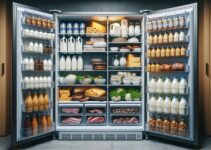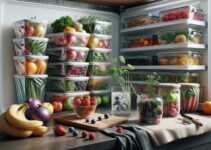Building a solid food storage plan doesn't have to break the bank. You're smart to think about stocking up, especially since life's full of surprises. But let's face it, you don't want to spend a fortune to be prepared.
You've probably wondered if affordable food storage means compromising on quality. It's a valid concern—cheap can often equate to low-quality, especially when it comes to pre-made food storage packages. You want good food that's ready when you need it, without the scary price tag.
Luckily, there are clever ways to store food for the short term without cluttering your space or emptying your wallet. Imagine tucking away a supply of shelf-stable foods under your bed in rolling totes, making the most of every inch. It's doable, and we'll show you how.
Benefits of Short Term Food Storage
Cost Savings
Affordable short-term food storage strategies can significantly reduce your grocery bills. By capitalizing on sales, you're stocking up on essentials at a fraction of their regular price. Imagine snagging cans of pineapple or pasta that usually cost $1.20 per unit for just $0.80—a notable 33% savings by buying in bulk. You won't just save on individual items; the practice of buying multipacks and larger quantities when discounts strike means your cost per serving plummets.
Here's a snapshot of potential savings:
| Item | Regular Price | Sale Price | Savings |
|---|---|---|---|
| Can of Pineapple | $1.20 | $0.80 | $0.40 |
| Box of Pasta | $1.50 | $1.00 | $0.50 |
By incorporating such strategies, you may also stretch your SNAP benefits or WIC program resources further, getting more nutritional bang for your buck.
Convenience
Short-term food storage offers undeniable convenience. Keeping a read-to-eat selection of box and can entrees ensures you're always ready to whip up a quick meal without the effort of soaking beans or baking bread from scratch. In today's hectic world, having go-to meals that require minimal prep time is a game-changer. Additionally, using storage containers helps maintain an organized kitchen, where food items are easy to find and not forgotten at the back of a cluttered pantry—cutting down on meal prep time and frustration.
Food Security
In finalizing your short-term food storage plan, you're also securing peace of mind. Food insecurity is a pressing issue, and having a stocked pantry means you're prepared for unexpected life events that impact food availability. Whether it's a natural disaster, a sudden job loss, or living in a food desert with limited access to fresh produce, your food storage acts as a safety net. It’s also a buffer for the days when making it to the grocery store isn’t an option. For families, this means continuity in meal patterns which is critical, especially when participating in nutrition assistance programs like the National School Lunch Program. Stocked shelves ensure that come what may, your family has access to healthy food options.
Factors to Consider for Affordable Short Term Food Storage
When it comes to maintaining an efficient and affordable short-term food storage, several factors need your attention. Understanding these components will help you optimize your storage while keeping costs manageable and ensuring your food remains healthy and ready-to-eat.
Shelf Life
When selecting items for your short-term food storage, always consider the shelf life. It's best to choose foods that are naturally longer-lasting and require minimal preservation methods. Common pantry staples like pasta, bread, and dehydrated foods can be kept at room temperature and are ready-to-use, simplifying your meal preparation and reducing waste. Moreover, incorporating methods like freezing can extend the shelf life of perishable goods, adding another layer of convenience and food security to your storage plan.
Cost
Budgeting is crucial for affordable food storage. SNAP benefits and the WIC program, which is the Special Supplemental Nutrition Program for Women, Infants, and Children, offer nutrition assistance and can be used for purchasing many staple food items. Take advantage of these programs if you're eligible, and use coupons or sales to stock up on nutritious options at reduced prices. Remember to conduct price comparisons; buying individually instead of in bulk packages may sometimes be more cost-effective, allowing your funds to stretch further towards other healthy food choices.
Storage Space
Maximize your storage space by using efficient preservation techniques like canning and vacuum sealing. These methods not only save space but also keep food fresh for longer periods. To fully employ your available space, consider using stackable containers and shelving, and be mindful of the size, weight, and shape of the foods you choose. Adequate organization in your storage area ensures that you can access everything quickly and reduces the risk of items being forgotten or wasted. It's a balance of function and form, where every square inch of space counts towards maintaining an organized and functional food storage area.
By keeping these factors in mind, you'll be on your way to creating a short-term food storage system that's both affordable and tailored to your needs. With careful planning and savvy shopping, you can ensure that you have a steady supply of nutritious food that supports you and your family's well-being.
Affordable Short Term Food Storage Solutions
Maintaining a stockpile of your essential food supplies ensures food security for you and your family in case of emergency. Not all storage solutions need to drill a hole in your wallet, and finding ways to preserve healthy food affordably is simpler than you might think.
Canned Goods
Canned goods are a staple in effective short-term food storage strategies due to their lengthy shelf life and convenience. When considering ready-to-eat options, prioritize nutritious and versatile items. A diverse selection of canned proteins, such as tuna, salmon, and other meats, forms the backbone of a balanced diet. For a well-rounded pantry:
- 15 cans of assorted fish
- 3 dozen cans of assorted meats (chicken, beef, corned beef)
- 25 cans of assorted vegetables
- 25 cans of mixed fruits and soups
Using snap benefits or enrolling in nutrition assistance programs like the WIC program can help you stock up on these essentials without stretching your budget. Remember to check for sales and bulk deals to further maximize your savings.
Dry Goods
Dry goods are equally critical in your supply of affordable food storage. Items like rice, pasta, and cereals provide carbohydrates necessary for energy. When shopping, choose whole grains for their nutritional value. Consider adding 20-30 pounds of Pinto Beans to your storage—they're not only cost-effective but also a hearty source of protein and fiber. Here's a list of grains to keep in your inventory:
- Brown rice
- Whole grain flours
- Oatmeal
- Assorted pastas (including gluten-full or gluten-free options)
Drying techniques, such as using a dehydrator, can prolong the shelf life of these foods and preserve their nutritional content. This preservation method is especially useful if you have excess produce from your garden or find a good deal at the farmers' market.
Vacuum Sealed Bags
Vacuum sealing is a game-changer for enhancing the shelf life of many foods. By removing air, vacuum-sealed bags prevent the growth of bacteria and fungi. This method is ideal for protecting the quality of dehydrated foods and for extending the usefulness of perishable items like cheese and bread. If you're looking for an efficient storage solution, consider investing in a vacuum sealer. It can be particularly beneficial for those who:
- Buy in bulk to save money
- Hunt or fish and want to preserve their catch
- Grow their own fruits and vegetables
Vacuum-sealed foods maintain their flavor and nutritional value longer and can be a fantastic addition to your short-term food storage plan, complementing canned and dry goods. Moreover, vacuum sealing is an excellent method to pack and seal ready-to-eat meals, making meal preparation more convenient in busy times or emergencies.
Incorporating these solutions into your food storage plan not only provides a secure food supply but also contributes to a healthier lifestyle by allowing you to store a wide range of nourishing foods. Remember, the essence of food storage is to ensure you always have access to healthy, appetizing options, regardless of circumstances.
Tips for Proper Short Term Food Storage
Rotation System
Implementing a reliable rotation system in your short-term food storage practice ensures that you're maximizing the shelf life of your edible items and minimizing waste. FIFO—First In, First Out—is your go-to strategy. Start by placing newly purchased items in the back of your pantry or storage area, allowing the older stock to be used first. Large, visible dates marked on your items with a Sharpie will keep you informed about which products to consume before reaching expiration. This habit not only promotes a continuous cycle of freshness but also contributes to a sustainable routine by avoiding the disposal of expired foods.
One simple rotation plan you can execute involves checking your inventory periodically and organizing your space so that your older stock, be it canned vegetables, whole-grain pasta, or dehydrated foods, remains accessible. Should you have benefits like SNAP or the Special Supplemental Nutrition Program for Women, Infants, and Children (WIC), ensure to prioritize using items procured on these programs sooner to keep your food security stable.
Temperature and Humidity Control
Maintaining the right temperature and humidity levels in your storage spaces is crucial for food preservation. For short-term storage, aim to keep the temperature consistent, ideally between 50-70°F. Avoid places where temperature fluctuations are common, like garages or attics, as this can affect the integrity of your food, especially canned goods and vacuum-sealed items. Humidity can also be the enemy of long-lasting food, leading to mold and spoilage. If necessary, employ a dehumidifier to maintain a relatively dry environment where your stash of nutritious essentials, including bread, healthy snacks, and ready-to-eat meals, can remain unaffected.
For those living in food deserts with limited fresh food access, paying attention to these factors can extend the life of your food items, allowing you to make the most of your available resources, including national programs like SNAP or the National School Lunch Program.
Pest Prevention
Pests are a threat to your food storage, capable of creating health hazards and ruining your stockpile. Pest Prevention doesn't have to be elaborate; it begins with maintaining a clean storage environment. Immediately clean up spills, keep food in secure containers (ideally with sealing options), and ensure that grains and pasta are stored in airtight conditions to deter invaders. Periodically inspect your storage area for signs of pests and address any potential entry points they could exploit.
By staying vigilant against pests, your food reserves, particularly those intended for young children or infants participating in the WIC program, will remain safe and uncontaminated. This diligence also serves to protect your investment in healthy food options and supports the overall goal of nurturing food security in your home.
Conclusion
You've got the tools to keep your food fresh and your wallet happy. Remember, a smart rotation system with FIFO principles, coupled with vigilant date marking, will keep your pantry in top shape. Keep that temperature steady and the humidity at bay to ensure your food's longevity. And don't overlook the importance of a clean, pest-free environment—it's essential for safeguarding your supplies. By following these straightforward strategies, you'll enjoy the benefits of an efficiently managed food storage system that supports both your dietary needs and your budget.
Frequently Asked Questions
How can I ensure my short-term food storage is effective?
To ensure effective short-term food storage, implement a rotation system like FIFO (First In, First Out), keep a consistent temperature between 50-70°F, use a dehumidifier to maintain dry conditions, and store food in secure containers to prevent pests.
What is FIFO and how does it apply to food storage?
FIFO stands for First In, First Out, and in food storage, it means using the oldest items first to minimize waste and ensure the freshest food supply.
What temperature range is best for storing food short-term?
A consistent temperature between 50-70°F is recommended for short-term food storage to preserve the quality and longevity of food items.
How does humidity affect food storage?
Humidity can lead to the degradation of food quality through mold growth and spoilage. Using a dehumidifier can help maintain a dry environment and preserve food.
What are some tips for pest prevention in food storage?
To prevent pests, keep the storage area clean, use secure, airtight containers for food, and perform periodic inspections for signs of infestation.





